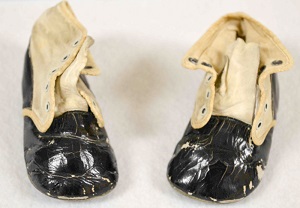
“There’s that old saying, ‘Those who cannot remember the past are condemned to repeat it.’ These are a real example of harassment that people were subjected to, as a predecessor to the Holocaust. We need to learn from history, and to be overly committed to the principles of freedom, and of civil liberties.”
Hillel Cohn is Rabbi emeritus at Temple Emanu El in San Bernardino and he is active in numerous community organizations. In many ways, it is hard to imagine San Bernardino without him. And yet, that easily could have been a reality. Rabbi Cohn escaped from Nazi Germany with his family when he was an infant. The identity documents issued to him and his parents are on display.
These are German government identity cards. They conspicuously have a ‘J’ on the front. Each one also bears on it the stamp of the police of Berlin with the swastika on it. Wherever you went you had to show your ID, which meant that you could be harassed, spit at, tossed out of the store, not served – a whole variety of things. It was the predecessor to when Jews had to wear a yellow star.
By the late 1930s, the government had begun to round up Jewish males and place them in temporary concentration camps – particularly public figures, such as Rabbi Cohn’s father, who was also a rabbi.
The word was out that they were going to come and get my father. My sister was three years old at the time -- what would happen if they asked her, ‘Where’s your father?’ She might tell them where he was – he was in hiding with other relatives in the cemetery in freshly dug graves. So my mother took us on the subway for 72 hours, so we wouldn’t be in the apartment when they came to look for him.
The family was able to leave when they were issued a visa for travel to the US in June of 1938.
My father and sister stood in line at the Consulate in Berlin for two or three days. My sister happened to be a very charming little three-year-old, and one of the young American consulate officers took a liking to her. He took my father and my sister to the front and issued them a slip. In a couple of days, we were able to leave. That was kind of a miraculous way to be able to get out.
Rabbi Cohn would hear very little about the Holocaust while growing up in the Pacific Northwest.
People were reluctant to talk about it. Even in the synagogue, we didn’t teach about it immediately after. The survivors were reluctant to dwell on it. They wanted to push that experience back.
Still, there were traces of the tragedy that had occurred. After the War concluded, Rabbi Cohn’s parents got word of perished family members, and those who had survived. And there were little reminders.
Another thing I remember is when I was six or seven years old in grammar school, kids joined the Cub Scouts. And my parents would not let me join. Why? Because it involved wearing a uniform. And to them, with the image of the Nazi youths in their brown shirts, Cub Scouts was just too much to take.
While Rabbi Cohn has always been cognizant of how lucky he is to be alive, the weight of such providence struck him only upon a trip to visit Auschwitz with his son.
There is a museum there, with cabinets piled with things confiscated from the Jews -- false teeth in one, combs and brushes in another. Then in the next room there are things taken from the children. Out of eleven million victims of the Holocaust, 1.5 million were children. Among the children’s displays was a case of baby shoes. My eyes were riveted on a particular pair of shoes. I looked and I said, ‘Those look exactly like the ones my grandparents gave me.’
Rabbi Cohn’s shoes, identical to the ones he saw at Auschwitz, are displayed here.